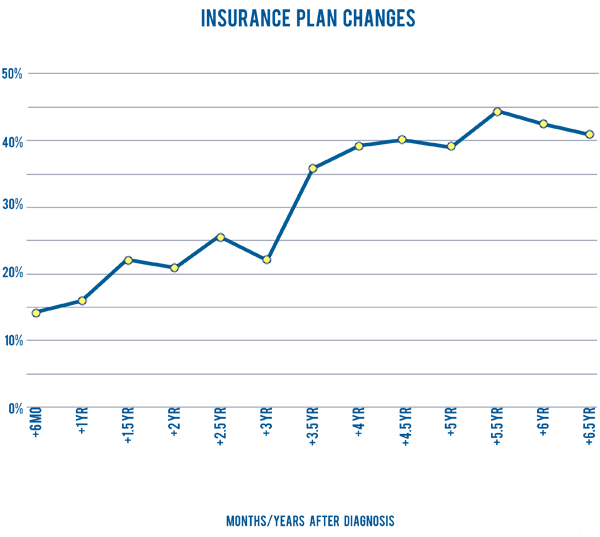Survey Facts: Since Diagnosis
- Survey Facts: Participation (Facts 1 through 5)
- Survey Facts: Family History (Facts 6 through 9)
- Survey Facts: At Diagnosis (Facts 10 through 21)
- Survey Facts: Since Diagnosis (Facts 22 through 34)
What has happened since diagnosis?
Over 1,500 Follow-Up Surveys have been completed by families with children in treatment or who have completed treatment. Many families have taken the Follow-Up Survey more than once at different times after diagnosis. This allows families to share how their experiences, attitudes and circumstances change over time.
SURVEY FACT 22:
At least half of children are still receiving treatment for childhood cancer for 2 years after diagnosis. At 4 years and beyond, only about 1 in 10 children is still receiving treatment

SURVEY FACT 23:
The majority of children with childhood cancer have completed IV chemotherapy treatment during the first three years following diagnosis.

SURVEY FACT 24:
As many as 4 out of 5 children experience unwanted side effects as a result of cancer or treatment for several years after a childhood cancer diagnosis.

SURVEY FACT 25:
Impact on immunity, appearance, nutrition and neurological health are reported the most by families following a childhood cancer diagnosis. Change in appetite, nausea/vomiting, hair loss and immune response are reported less over time while learning difficulties and loss of hearing are reported more.

SURVEY FACT 26:
School attendance is significantly impacted by a childhood cancer diagnosis. In the first year following diagnosis, at least 4 out of 5 children miss more than 20 days of school per year.
Up to 5.5 years after diagnosis, at least 1 out of 5 children misses more than 20 days of school per year.
SURVEY FACT 27:
For those living with childhood cancer, the percentage of children participating in both team and individual sport activities declines sharply in the first year after diagnosis, but then gradually return towards previous levels. This return takes a little longer for those in team sports (6+ years) vs. individual sports (3.5 years).

SURVEY FACT 28:
Two of the strongest emotions experienced by database participants at diagnosis, fear and sadness, become less prominent over time. Worry, however, is an emotion which remains quite common for many years.

SURVEY FACT 29:
The oncologist/oncologist’s office and other parents of children with cancer provide the most valuable information to families with childhood cancer.

SURVEY FACT 30:
Almost half of My Childhood Cancer: Survey Series participants mentioned the need for additional information, specifically for better hospital resources, emotional support and/or support groups.
SURVEY FACT 31:
Less than 2 out of 10 families change insurance plans in the first year following diagnosis. This doubles to approximately 4 out of 10 families at 4 years after diagnosis and beyond.

SURVEY FACT 32:
In the 2 years following a childhood cancer diagnosis a decrease in annual household income is more common than an increase. At the same time, significant increases are seen in the unemployment of at least one caregiver as well as families with one caregiver taking a temporary leave of absence from work.

SURVEY FACT 33:
Many families have difficulties paying for childcare with 1 in 3 families not able to cover these costs with their normal household income at 6 months after diagnosis.

SURVEY FACT 34:
After a childhood cancer diagnosis, there is a slight increase in the proportion of respondents that indicated they are married. This only decreases after 6 years.



